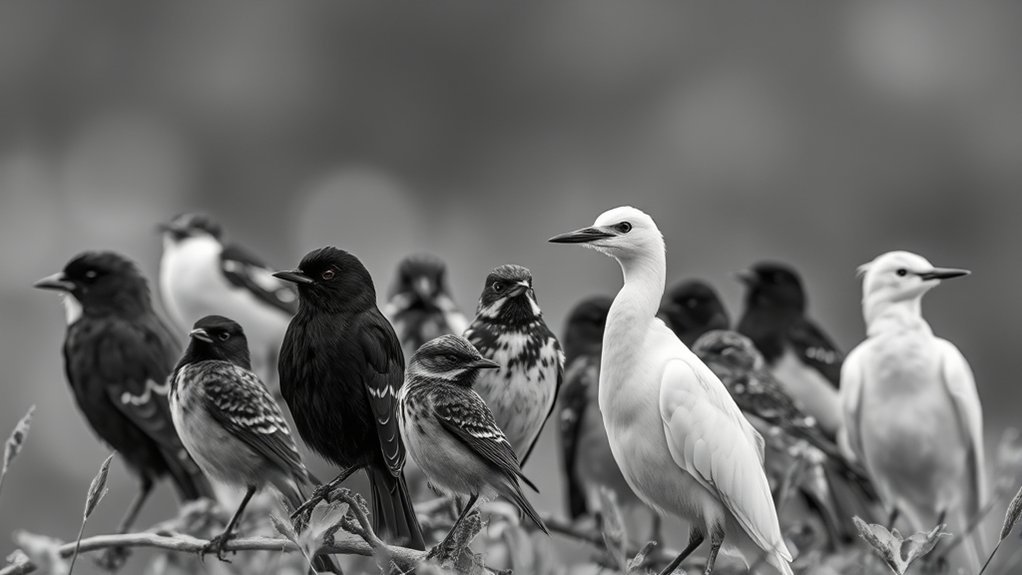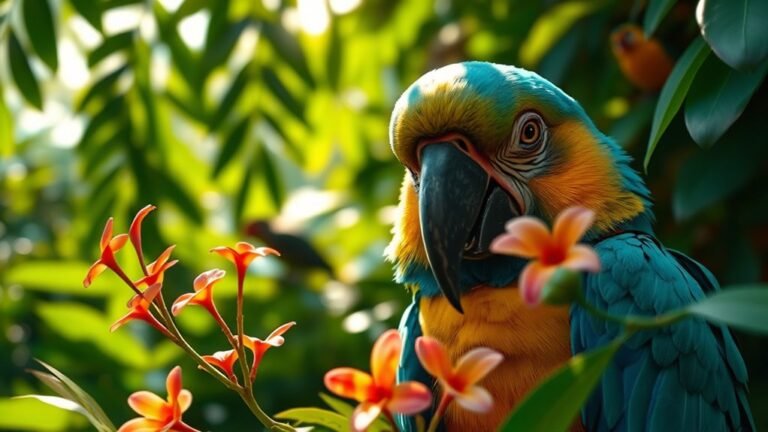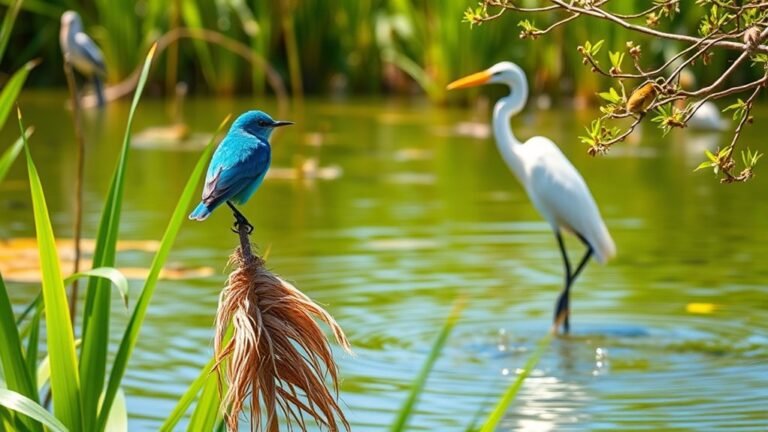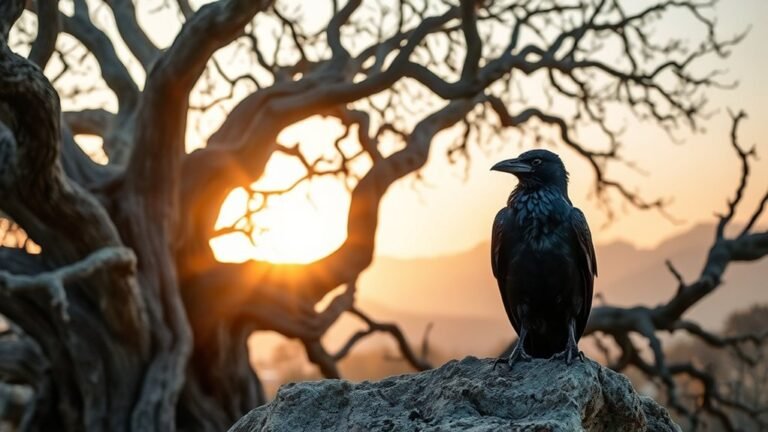The Ultimate Guide to 26 Black and White Birds With Pictures
Black and white birds are interesting creatures. They have unique features that help them survive in different environments. For example, the American Oystercatcher and the Black-capped Chickadee have beautiful feathers. These birds also use special strategies to stay alive.
When you learn about their homes and daily activities, you can see how they adapt to nature. This understanding helps us appreciate all the different kinds of birds we have. Each bird teaches us something new. What can we learn from these black and white birds?
A Quick Overview
- Check out different black and white birds like the American Oystercatcher, Killdeer, and Black Skimmer. They have special features that can help you identify them.
- Find out where birds like the Black-capped Chickadee and Killdeer live and how they behave. This will make your birdwatching more fun.
- Learn about what black and white birds eat. For example, the Black-tailed Godwit has cool ways to find food.
- Discover how birds like the Black-headed Grosbeak and Common Murre court and build nests. Understanding their life cycles can be interesting.
- Listen to how these birds communicate. Knowing their sounds can add more joy to your birdwatching adventures.
American Oystercatcher
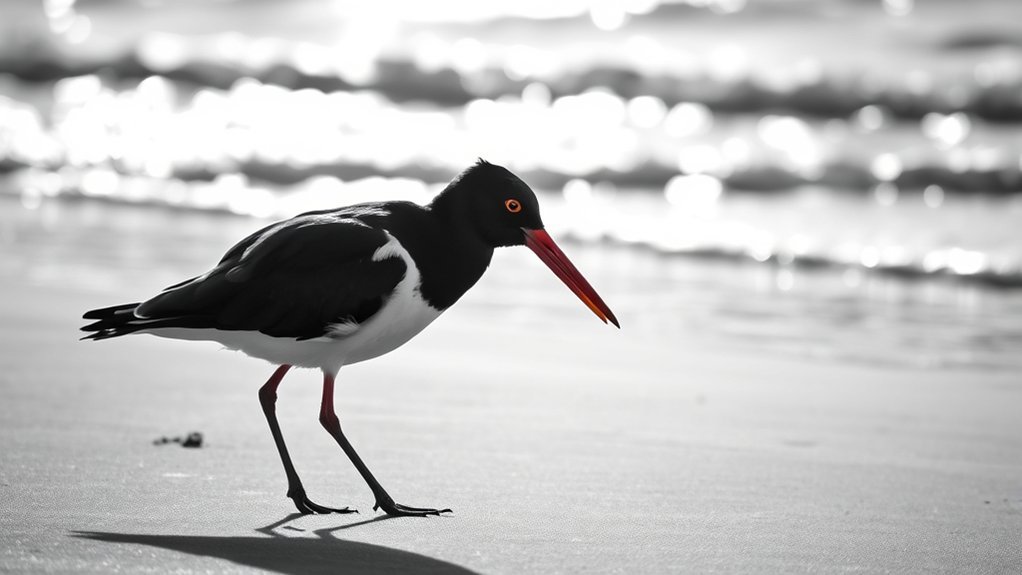
The American Oystercatcher is a cool shorebird that you can spot along the coast. It has striking black and white feathers that make it easy to recognize. These birds like to hang out in places like sandy beaches and tidal flats.
Oystercatchers have a special way of finding food. They use their long, strong bills to open shellfish. This skill helps them find yummy treats hidden in the sand or mud. You might see them searching for food alone or with a few friends. They rely on their sharp eyes to spot tasty snacks.
When they communicate, Oystercatchers make loud sounds. This helps them connect with each other, especially when they're with their mates.
Learning about their homes and what they do can help you appreciate these amazing birds even more. Join other nature lovers and enjoy watching the American Oystercatcher on our beautiful shores!
Black-capped Chickadee
Spotting a Black-capped Chickadee in your backyard is a fun experience! This small bird is about 4.7 inches long. You can easily recognize it by its black cap and bib, white cheeks, and soft gray sides. Knowing more about the Black-capped Chickadee helps you enjoy its busy and cheerful nature.
These birds live in many places. They like forests with trees and can also be found in neighborhoods with lots of green. You might see them flying around bird feeders or hear their cute song that goes "chick-a-dee-dee-dee."
Watching how they act is a joy. They're curious and can do flips and turns in the air. This makes birdwatching even more exciting!
Black Skimmer

Black Skimmers are interesting birds that stand out because of their looks and how they hunt for food. They live on sandy beaches and in estuaries near the coast. These places are perfect for them to find food.
Here are some cool facts about how Black Skimmers feed and where they live:
- How They Eat: Black Skimmers have a special way of catching fish. They fly low over the water and use their long, bottom beak to skim the surface and catch small fish.
- Where They Nest: They like to make their homes in quiet, sandy areas. These places are just right for laying their eggs and raising their chicks.
- Seasonal Movement: When it's time to migrate, Black Skimmers move along the coast. They adjust to different spots but still hunt for food in the same way.
Learning about where Black Skimmers live and how they feed makes you appreciate these amazing birds even more!
Black-and-white Warbler
The Black-and-white Warbler is a small songbird with striking black-and-white feathers. You can often find it in the bushes and trees of eastern North America. This bird likes to live in places with lots of trees and shrubs, where it can easily hop around.
What makes the Black-and-white Warbler special is how it finds food. You might see it climbing up tree trunks and branches. It looks for insects and larvae hiding under the bark. Unlike most warblers, this bird can climb really well. It uses its feet to hold onto surfaces as it moves up.
Learning about the Black-and-white Warbler can make birdwatching more fun. It helps you notice its unique ways and understand where it lives. This connection can deepen your appreciation for nature and all its wonders.
Eurasian Magpie

The Eurasian Magpie is a beautiful and smart bird that many people enjoy watching. Here's some easy information about this interesting bird:
- Eurasian Magpie Behavior: These birds are clever! They can solve problems, use tools, and interact with each other in interesting ways.
- Eurasian Magpie Habitat: You can spot them in many places like cities, forests, and fields. They're great builders and make complex nests.
- Diet and Foraging: They eat a mix of foods, such as insects, seeds, and small animals. This shows how adaptable they are.
The Eurasian Magpie is a mix of beauty and brains, making it a fun bird for anyone who loves nature.
Downy Woodpecker
The Downy Woodpecker is a small and beautiful bird found in North America. You can see it in many places, like forests, parks, and gardens with trees.
It loves to explore the trunks and branches of trees, tapping on them to find insects.
This bird eats beetles, caterpillars, and ants. It also enjoys seeds and fruits when they're around.
The Downy Woodpecker is good at finding food in different places, which helps it thrive. Watching this bird and its unique habits can make you feel closer to nature.
Birdwatchers often find joy in seeing their delightful behaviors.
Great Black-backed Gull
The Great Black-backed Gull is a large and striking bird found along coastlines. Here's what makes it special:
- Diet: This gull likes to eat fish, crustaceans, and even dead animals. It shows that it can find food in many different ways.
- Behavior: The Great Black-backed Gull is known for being bossy. It often pushes other seabirds around to get what it wants.
- Breeding: These gulls build their nests on cliffs or islands. They take good care of their young to help them grow strong.
You can spot them easily because of their size and unique look. They play an important role in their environment by being bold and adaptable.
Pied-billed Grebe
The Pied-billed Grebe is a small bird that loves living in freshwater places like ponds and lakes in North America.
It spends most of its time in marshes where there are lots of plants. This bird is quick and can dive underwater to catch food like fish and frogs.
During the time when they mate, these grebes put on fun shows. They bob their heads and move in sync, which helps them form strong pairs.
Their feathers are colored to blend in with the water, making it hard for predators to spot them and helping them catch dinner.
Learning about where they live and how they act can help you appreciate this cool water bird even more!
White-throated Sparrow
The White-throated Sparrow is a beautiful bird. You can find it in thick bushes and along the edges of forests. Its bright white throat and unique head stripes make it easy to recognize. This bird likes to hang out where it can hide and look for food.
Here are three important things about how the White-throated Sparrow lives:
- Eating: This bird eats a mix of food. It looks for seeds, bugs, and berries. You might see it scratching around in the leaves to find tasty treats.
- Nesting: When it's time to have babies, the White-throated Sparrow chooses mixed forests. It makes its nest low to the ground in hidden spots.
- Traveling: During migration, it likes to stay in areas with bushes. In the winter, it moves to open woods.
Knowing these facts helps you appreciate how important the White-throated Sparrow is in its home. It plays a big role in the environment!
Barn Owl
The Barn Owl is a special bird with a heart-shaped face and light-colored feathers. It's great at hunting at night. These owls live in barns and old buildings, which helps them sneak up on their food. They fly quietly and can hear very well, so they find food even when it's dark.
Barn Owls often hang out in groups in old structures. This helps other animals too by supporting a healthy environment on farms. They mainly eat small animals like mice, which helps keep pest numbers down.
Watching these fascinating birds can teach you a lot about their behaviors. It's important to protect their homes, like barns, so future generations can enjoy them too.
Barn Owls aren't just interesting; they also play a key role in keeping ecosystems healthy!
Common Murre
Common Murres are amazing seabirds. They've black and white feathers and are great at diving. You can find these birds along coastlines, where they like to live on steep cliffs and rocky shores. They often form big groups and work together when they dive for fish, showing off their quick movements.
Here are three interesting things about common murre behavior:
- Nesting: They make their nests on high cliffs that are hard to reach. Each couple lays one egg and both parents take care of it.
- Foraging: Common Murres can dive really deep, going down as far as 200 feet to catch fish.
- Communication: They talk to each other with different sounds during mating and nesting times. This helps them stay close as a group.
Learning about these birds makes you appreciate how unique they are!
Raven
Ravens are amazing birds. They're smart and can adapt to many places, from busy cities to quiet forests. You might've heard stories about them. In different cultures, ravens often stand for change, wisdom, and sometimes a bit of mischief.
One cool thing about ravens is how they solve problems. They can figure out tricky situations, just like some monkeys do. When you watch them play—like throwing sticks or copying sounds—you see how lively they are.
Ravens also work together to find food. They talk to each other using different sounds and can share their thoughts in interesting ways.
Northern Flicker
You might see a Northern Flicker flying around in trees, but don't confuse it with other woodpeckers. These birds are special because of their interesting habits and colorful looks. They live in many places, like forests and cities.
Here are some cool facts about Northern Flickers:
- Eating habits: Unlike most woodpeckers, Northern Flickers like to search for food on the ground. They enjoy eating ants and beetles.
- Sounds: They make different noises, from sharp chirps to loud drumming. These sounds help them mark their territory.
- Nesting: Northern Flickers like to build their nests in tree holes. They often reuse and change old holes to make them fit for their needs.
Take a moment to watch these amazing birds. They show us how well living things can adapt and thrive in our environment.
California Gull
The California Gull is a special bird that lives near the coast. You can find it along the western beaches, in estuaries, and even in towns. This bird has beautiful feathers and is very good at finding food. It eats many things like fish and leftover food from people.
California Gulls are very social. You often see them in big groups, especially when they're nesting in the spring. They make different sounds, from sharp calls to gentle cackles. These sounds help them communicate with each other.
Learning about the California Gull helps you see how they live and interact with one another. It connects you to nature and shows how amazing these birds really are!
Black-headed Grosbeak
After learning about the California Gull, let's talk about the Black-headed Grosbeak. This bird is an interesting sight with its bright colors and strong body.
It behaves in ways that many bird watchers find really cool. You can often see this bird in places like dense bushes, pine forests, and near rivers.
Here are three important things to know about the Black-headed Grosbeak:
- What It Eats: This bird likes to eat seeds, berries, and insects.
- Breeding Time: The Grosbeak usually breeds in the spring and early summer.
- Songs: Male Grosbeaks sing pretty songs to help them find mates.
Learning about these facts can help you enjoy watching this amazing bird even more!
Masked Booby
The Masked Booby is a cool seabird with beautiful feathers and big wings. You can spot these birds in warm oceans, especially near coastal cliffs and faraway islands. They love places where they can find a lot of fish because they catch their food by diving into the water.
When it's time to nest, Masked Boobies like to live in groups. They usually lay their eggs on the ground or on rocky spots. This helps them stay safe from predators, and they often help each other take care of the babies.
Watching how they court and build nests is pretty neat and makes you feel closer to these amazing birds.
Osprey
Ospreys are amazing birds that live near water. You can often see them flying smoothly over lakes, rivers, and coastlines. They're very good at catching fish. With their sharp eyesight, they can spot fish from high above. When they dive down to catch their meal, they can go really fast, up to 40 miles per hour!
If you want to learn more about Ospreys, here are three cool things to know:
- Hunting Skills: Ospreys dive into the water to catch fish. They use their strong, curved talons to grab their food.
- Nesting: Ospreys build big nests close to water. They use sticks and plants to make sure their nests are safe and near where they can find food.
- Migration: Many Ospreys travel long distances every year. They've a great sense of direction to find their way.
Isn't it fun to learn about these incredible birds? Ospreys are fascinating creatures that show us the wonders of nature!
Long-tailed Duck
The Long-tailed Duck is a special bird you may not see all the time, but it's fun to watch. This bird is easy to spot because of its unique look.
Long-tailed Ducks migrate from the Arctic to warmer coastal waters for the winter. They travel far from their breeding spots to find a cozy place to live during the cold months.
When feeding, Long-tailed Ducks dive underwater. They eat mostly crustaceans, mollusks, and small water creatures. These ducks are great swimmers and can dive deep to find their food.
Seeing a Long-tailed Duck can bring joy to birdwatchers. They make birdwatching trips more exciting, especially for those who love black and white birds. Their presence adds diversity to any outing.
Eastern Towhee
The Eastern Towhee is a beautiful black and white bird that many birdwatchers love. It has bright feathers and a special call that makes it stand out. You can see this bird in different places like shrubby areas, woods, and even in suburban gardens.
It has some cool habits too, like foraging on the ground. It kicks up leaves to find seeds and insects hidden beneath.
Here are three interesting things about the Eastern Towhee:
- Territorial Displays: Male Eastern Towhees make sounds and show off their bodies to claim their space and keep other males away.
- Diet: These birds eat seeds, berries, and insects, changing what they eat based on what's available during the season.
- Breeding: They usually build their nests in thick bushes. This helps keep their young safe from predators.
Learning about these traits makes you appreciate the Eastern Towhee even more!
Black-winged Stilt
The Black-winged Stilt is a beautiful shorebird found in wetlands in Europe, Asia, and Africa.
These birds like to live in shallow water, such as marshes, lagoons, and estuaries, where they can easily find food.
They have long, thin legs that help them wade through the water. As they move, they stir up the mud to find small insects and tiny creatures to eat. Their slender bodies and long, pink legs make them look very elegant.
Watching these birds while they search for food is interesting.
They help keep the environment healthy by showing us the state of aquatic ecosystems. The Black-winged Stilt is truly a lovely part of nature.
White-tailed Eagle
The White-tailed Eagle is a stunning bird that you can see flying over coasts and big lakes.
It has a big wingspan that can grow to more than two meters! This bird builds large nests in tall trees or on cliffs, and it often uses the same nest for many years.
Learning about these eagles is important because it helps protect them and keep them safe.
Here are three key facts about the White-tailed Eagle:
- Diet: It mainly eats fish but also likes waterfowl and small animals.
- Breeding: White-tailed Eagles usually mate for life and lay 1 to 3 eggs at a time.
- Habitat: They prefer to live in mature forests near water.
These facts make the White-tailed Eagle an interesting and important part of nature!
Killdeer
Have you ever seen a Killdeer? This bird runs around on the ground and has some cool features that make it stand out. It has two black bands around its neck and behaves in interesting ways.
Killdeers like to live in open places with sand, especially near water, like gravel areas, fields, and farms.
When it's time to have babies, Killdeers start nesting. They make shallow pits in the ground and often cover their eggs with small stones and dirt to keep them safe.
Both mom and dad Killdeer help take care of the eggs and baby birds. They use loud calls to warn away predators, showing how much they protect their little ones.
Watching these birds can be a fun experience!
Black-tailed Godwit
After watching the Killdeer, you may want to learn about another interesting shorebird: the Black-tailed Godwit. This bird is known for its unique migration. It travels from its breeding homes in northern Europe and Asia to warmer wetlands during the winter months.
Here are some key points about the Black-tailed Godwit:
- Breeding Behavior: The Black-tailed Godwit makes its nest on the ground in open areas. They often perform special courtship dances to attract mates.
- Feeding Habits: This bird uses its long bill to search for small animals in the mud. It's skilled at finding food in muddy places.
- Conservation Status: Some groups of Black-tailed Godwits are losing their homes due to land changes. Knowing where they migrate is important to help protect them.
Learning about the Black-tailed Godwit can help you appreciate the variety of birds.
White-crowned Sparrow
The White-crowned Sparrow is easy to spot because of its black-and-white striped head. This bird lives all over North America in places like open woods, brushy spots, and weedy fields.
These areas help them find cover and seeds to eat. Seeds from grasses, weeds, and shrubs make up most of their diet. They also eat some insects during breeding season.
Watching these birds is fun. Their songs are special, and their habits are interesting.
If you learn more about what they like and how they act, you can enjoy your birdwatching trips even more. These beautiful birds can bring a lot of joy to anyone who takes the time to observe them!
Snowy Owl
The Snowy Owl is a beautiful bird with bright white feathers and striking yellow eyes. It lives in the cold areas of the Arctic, where it finds plenty of space to hunt.
Snowy Owls love open fields and tundras for their homes.
These owls are great hunters. Here's how they catch their food:
- Sharp Eyes: Snowy Owls can see very well, even in dim light. This helps them spot their prey easily.
- Quiet Flight: Their special feathers make them fly silently, so they can sneak up on their food without making a sound.
- Varied Menu: They mainly eat lemmings but can eat other animals when lemmings aren't around.
Learning about the Snowy Owl helps us understand its important role in nature.
These amazing birds remind us of how wonderful and unique wildlife can be!
Australian Magpie
The Australian Magpie is a special bird in Australia. It has bright black and white feathers and sings beautiful songs. You can see these birds in parks, fields, and forests. They're very good at living in different places.
Australian Magpies are smart and social. They work together, especially when they've babies. You can watch them defend their nests fiercely, showing how protective they are.
They also can mimic sounds, which makes their singing even more interesting.
The Australian Magpie plays an important role in nature and is loved by many people. Learning about this bird can help you appreciate its place in the Australian environment.
Frequently Asked Questions
What Are the Habitats of These Black and White Birds?
Black and white birds live in many different places. You can find them in forests, wetlands, and even near rivers. Each type of bird has its own favorite spot. This shows how well they can adapt to their surroundings. Their different habitats help keep birdlife thriving and interesting.
These birds are beautiful and have unique behaviors. Many people enjoy watching them in nature or in their backyards. Observing these birds can teach us about their lives and the environments they cherish.
How Can I Attract These Birds to My Backyard?
To attract black and white birds to your backyard, put up bird feeders filled with seeds. Choose a mix of seeds that these birds like. You can also plant native flowers and shrubs. These plants provide food and shelter for the birds. With these simple steps, you will create a welcoming space for them. Enjoy watching your new feathered friends!
What Do These Birds Typically Eat?
Birds like to eat seeds, insects, and fruits. If you know what they like, you can put out the right food for them in your backyard. This will make your yard a nice place for these beautiful birds to visit. Plus, watching them eat can be fun!
Are There Conservation Efforts for Any of These Species?
Yes, there are important efforts to help these birds. People are working hard to protect their homes and study their needs. This is so the birds can live better lives despite losing their habitats and facing changes in the environment.
How Do I Identify These Birds in the Wild?
To spot birds in the wild, pay close attention to their colors and shapes. Look at their feathers and beaks to notice details that make each bird unique. Also, listen for their calls. Different birds make different sounds, and these can help you tell them apart. Enjoy watching and listening to the birds around you!

Luna is the passionate founder and author of Birds and You, a website dedicated to sharing her love for birds with fellow enthusiasts. Through her engaging articles and guides, she aims to educate and inspire others to explore the fascinating world of birds. When she’s not writing, you can find Luna observing birds in their natural habitats or sharing beautiful bird photography on Pinterest. Join her on this journey to celebrate and protect our feathered friends!

